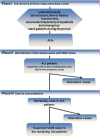Incidence of Suspected Serious Adverse Drug Reactions in Corona Virus Disease-19 Patients Detected by a Pharmacovigilance Program by Laboratory Signals in a Tertiary Hospital in Spain: Cautionary Data
- PMID: 33343374
- PMCID: PMC7744878
- DOI: 10.3389/fphar.2020.602841
Incidence of Suspected Serious Adverse Drug Reactions in Corona Virus Disease-19 Patients Detected by a Pharmacovigilance Program by Laboratory Signals in a Tertiary Hospital in Spain: Cautionary Data
Abstract
BACKGROUND: From March to April 2020, Spain was the center of the SARS-CoV-2 pandemic, particularly Madrid with approximately 30% of the cases in Spain. The aim of this study is to report the suspected serious adverse drug reactions (SADRs) in COVID-19 patients vs. non-COVID-19 patients detected by the prospective pharmacovigilance program based on automatic laboratory signals (ALSs) in the hospital (PPLSH) during that period. We also compared the results with the suspected SADRs detected during the same period for 2019. METHODS: All ALSs that reflected potential SADRs including neutropenia, pancytopenia, thrombocytopenia, anemia, eosinophilia, leukocytes in cerebrospinal fluid, hepatitis, pancreatitis, acute kidney injury, rhabdomyolysis, and hyponatremia were prospectively monitored in hospitalized patients during the study periods. We analyzed the incidence and the distribution of causative drugs for the COVID-19 patients. RESULTS: The incidence rate of SADRs detected in the COVID-19 patients was 760.63 (95% CI 707.89-816.01) per 10,000 patients, 4.75-fold higher than the SADR rate for non-COVID-19 patients (160.15 per 10,000 patients, 95% CI 137.09-186.80), and 5.84-fold higher than the SADR rate detected for the same period in 2019 (130.19 per 10,000 patients, 95% CI 109.53-154.36). The most frequently related drugs were tocilizumab (59.84%), dexketoprofen (13.93%), azithromycin (8.43%), lopinavir-ritonavir (7.35%), dexamethasone (7.62%), and chloroquine/hydroxychloroquine (6.91%). CONCLUSIONS: The incidence rate of SADRs detected by the PPSLH in patients with COVID-19 was 4.75-fold higher than that of the non-COVID-19 patients. Caution is recommended when using medications for COVID-19 patients, especially drugs that are hepatotoxic, myotoxic, and those that induce thromboembolic events.
Keywords: adverse (side) effects; adverse drug reaction; corona virus disease-19 (COVID-19); pharmacovigilance process; serious adverse drug reaction.
Copyright © 2020 Ramírez, Urroz, Rodríguez, González‐Muñoz, MartínVega, Villán, Seco, Monserrat, Frías, Carcas and Borobia.
Conflict of interest statement
The authors declare that the research was conducted in the absence of any commercial or financial relationships that could be construed as a potential conflict of interest.
Figures




Similar articles
-
Pharmacovigilance follow-up of patients in the context of the COVID-19 pandemic.Therapie. 2023 Sep-Oct;78(5):523-529. doi: 10.1016/j.therap.2023.01.004. Epub 2023 Jan 20. Therapie. 2023. PMID: 36754694 Free PMC article.
-
A pharmacovigilance program from laboratory signals for the detection and reporting of serious adverse drug reactions in hospitalized patients.Clin Pharmacol Ther. 2010 Jan;87(1):74-86. doi: 10.1038/clpt.2009.185. Epub 2009 Nov 4. Clin Pharmacol Ther. 2010. PMID: 19890254
-
Eosinophilic drug reactions detected by a prospective pharmacovigilance programme in a tertiary hospital.Br J Clin Pharmacol. 2017 Feb;83(2):400-415. doi: 10.1111/bcp.13096. Epub 2016 Oct 12. Br J Clin Pharmacol. 2017. PMID: 27543764 Free PMC article.
-
Emerging and experimental treatments for COVID-19 and drug interactions with psychotropic agents.Ther Adv Psychopharmacol. 2020 Jun 22;10:2045125320935306. doi: 10.1177/2045125320935306. eCollection 2020. Ther Adv Psychopharmacol. 2020. PMID: 32612804 Free PMC article. Review.
-
Data-driven methods to discover molecular determinants of serious adverse drug events.Clin Pharmacol Ther. 2009 Mar;85(3):259-68. doi: 10.1038/clpt.2008.274. Epub 2009 Jan 28. Clin Pharmacol Ther. 2009. PMID: 19177064 Free PMC article. Review.
Cited by
-
Impact of COVID-19 pandemic on liver, liver diseases, and liver transplantation programs in intensive care units.World J Hepatol. 2021 Oct 27;13(10):1215-1233. doi: 10.4254/wjh.v13.i10.1215. World J Hepatol. 2021. PMID: 34786163 Free PMC article. Review.
-
A narrative review on adverse drug reactions of COVID-19 treatments on the kidney.Open Med (Wars). 2024 Mar 15;19(1):20230867. doi: 10.1515/med-2023-0867. eCollection 2024. Open Med (Wars). 2024. PMID: 38584847 Free PMC article. Review.
-
Mucocutaneous presentations of consultant critical and non-critical cases of admitted COVID-19 patients, outpatients, and vaccine-associated dermatoses: a clinical atlas and a large original study of two general COVID-19 centers from Iran.Dermatol Reports. 2023 May 23;15(2):9473. doi: 10.4081/dr.2023.9473. eCollection 2023 Jun 7. Dermatol Reports. 2023. PMID: 37426367 Free PMC article.
-
A review on oral manifestations of COVID-19 disease.J Family Med Prim Care. 2022 Oct;11(10):5879-5886. doi: 10.4103/jfmpc.jfmpc_205_22. Epub 2022 Oct 31. J Family Med Prim Care. 2022. PMID: 36618227 Free PMC article. Review.
-
Drug reaction with eosinophilia and systemic symptoms in patients hospitalized with COVID-19: a case series from a large US healthcare system.Br J Dermatol. 2022 Oct;187(4):619-622. doi: 10.1111/bjd.21706. Epub 2022 Jul 12. Br J Dermatol. 2022. PMID: 35700153 Free PMC article. No abstract available.
References
-
- Aggarwal S., Garcia-Telles N., Aggarwal G., Lavie C., Lippi G., Henry B. M. (2020). Clinical features, laboratory characteristics, and outcomes of patients hospitalized with coronavirus disease 2019 (COVID-19): early report from the United States. Diagnosis (Berl) 7 (2), 91–96. 10.1515/dx-2020-0046. - DOI - PubMed
LinkOut - more resources
Full Text Sources
Miscellaneous

